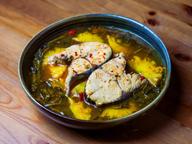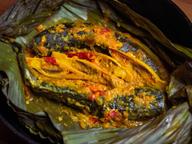
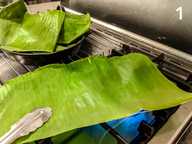
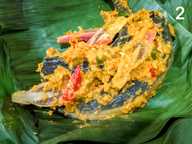
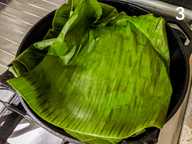
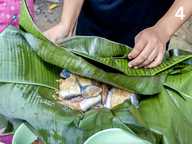
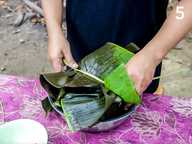
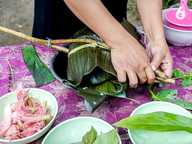


The Temuan way to cook this fish is over the embers of an outdoor stove. If you have an available setup, we highly encourage you to go for it. If you only have an oven available, we’ve devised an indoor method to get the same flavours (albeit less smoky).
Paeh ikan keli
by Lisa KoyokThe Temuan way to cook this fish is over the embers of an outdoor stove. If you have an available setup, we highly encourage you to go for it. If you only have an oven available, we’ve devised an indoor method to get the same flavours (albeit less smoky).
Servings: 4
Prep time: Slightly involved









Servings: 4
Prep time: Slightly involved
Ingredients
4 catfish, about 200g each, cleaned thoroughly
4 tbsp tempoyak OR 4 kulim leaves, torn or sliced
4 bunga kantan (torch ginger flower), sliced in half lengthways
Salt to taste
SPICE PASTE:
20 shallots OR 6 large red onions, roughly chopped
4 thumb-sized pieces ginger, roughly chopped
2 thumb-sized piece fresh turmeric, roughly chopped
6 stalks lemongrass, white part only, roughly chopped
4 large red chillies, roughly chopped
6 bird’s eye chillies/cili padi (optional, or more if you like it hot, and can be left whole if preferred)
MATERIAL FOR COOKING:
1 whole banana leaf, trimmed off the rib and washed, 4-5 leaves if cooking outdoors
1 covered cast iron skillet, dutch oven, or stainless steel skillet — any cooking vessel will do, as long as oven-safe (if using oven)
1 banana leaf rib (if cooking outdoors)
1 rattan stalk (if cooking outdoors)
Directions
- In a mortar and pestle or blender, grind all spice paste ingredients into a paste.
- If using an oven, preheat the oven to 180°C. If cooking outdoors, prepare your heat source. The heat should be at a medium, and the flame should have died out, reducing the wood or coal to embers.
- If using large catfish, cut into chunks about 2” long. If using small catfish, they can be cooked whole.
- Place catfish in a mixing bowl, and add the ground spice paste, tempoyak or kulim leaves, bunga kantan, and salt. Mix well, making sure the spice paste is in the cavity of the fish as well.
- Turn on your stove to a medium hight heat. With a pair of tongs, run the banana leaves over the open flame one by one with confidence, making sure that the color changes from a slightly dusty green to a shiny vibrant green (see photo numbered ‘1’ in gallery). This helps to soften the leaves and make them more pliable for wrapping.
IF USING AN OVEN:
- Line the cooking vessel of your choice (Editor’s note: we used a cast iron skillet) with at least two layers of banana leaves. Place the catfish and spice mixture in the middle of the banana leaves and wrap it up with the overhang (see photo numbered ‘2’ and ‘3’ in gallery). Cover the pan and place in the middle rack of the oven.
- Bake the fish for about 30 minutes. At this point, check every 5 minutes that the internal temperature of the fish has reached 63°C with a food thermometer.
- Once it reaches 63°C when tested at different points in the pan, take it out of the oven and unwrap to serve.
IF COOKING OUTDOORS:
- Line a separate mixing bowl with at least 6-8 layers of banana leaves. Place the catfish and spice mixture in the middle of the banana leaves and wrap it up carefully to ensure there are no leaks (see photo numbered ‘4’ in gallery). Tie the parcel up with the banana rib (see photo numbered ‘5’ in gallery), and secure the tied parcel with the rattan stalk (see photo numbered ‘6’ in gallery)
- Use the rattan stalk as a handle to place the parcel at the edge of the hot embers, making sure not to place it directly on the embers themselves (see photo numbered ‘7’ in gallery).
- Turn the fish every 10 minutes or so to ensure different sides of the parcel are being cooked evenly (see photo numbered ‘8’ in gallery).
- After about 30 minutes, check every 5 minutes that the internal temperature of the fish has reached 63°C with a food thermometer.
- Once it reaches 63°C when tested at different points of the parcel, remove it from the embers and unwrap to serve.
Tips
- A combination of various freshwater fish can also be used, such as puyu, sepat, and haruan with a weight totalling about 800g
- Lisa recommends using either tempoyak or kulim leaves in this preparation, though a combination of the two would undoubtedly result in better aroma.
- If rattan isn’t easily available, you can use a fish grilling mesh, which can be obtained online.
Ingredients
4 catfish, about 200g each, cleaned thoroughly
4 tbsp tempoyak OR 4 kulim leaves, torn or sliced
4 bunga kantan (torch ginger flower), sliced in half lengthways
Salt to taste
SPICE PASTE:
20 shallots OR 6 large red onions, roughly chopped
4 thumb-sized pieces ginger, roughly chopped
2 thumb-sized piece fresh turmeric, roughly chopped
6 stalks lemongrass, white part only, roughly chopped
4 large red chillies, roughly chopped
6 bird’s eye chillies/cili padi (optional, or more if you like it hot, and can be left whole if preferred)
MATERIAL FOR COOKING:
1 whole banana leaf, trimmed off the rib and washed, 4-5 leaves if cooking outdoors
1 covered cast iron skillet, dutch oven, or stainless steel skillet — any cooking vessel will do, as long as oven-safe (if using oven)
1 banana leaf rib (if cooking outdoors)
1 rattan stalk (if cooking outdoors)
Directions
- In a mortar and pestle or blender, grind all spice paste ingredients into a paste.
- If using an oven, preheat the oven to 180°C. If cooking outdoors, prepare your heat source. The heat should be at a medium, and the flame should have died out, reducing the wood or coal to embers.
- If using large catfish, cut into chunks about 2” long. If using small catfish, they can be cooked whole.
- Place catfish in a mixing bowl, and add the ground spice paste, tempoyak or kulim leaves, bunga kantan, and salt. Mix well, making sure the spice paste is in the cavity of the fish as well.
- Turn on your stove to a medium hight heat. With a pair of tongs, run the banana leaves over the open flame one by one with confidence, making sure that the color changes from a slightly dusty green to a shiny vibrant green (see photo numbered ‘1’ in gallery). This helps to soften the leaves and make them more pliable for wrapping.
IF USING AN OVEN:
- Line the cooking vessel of your choice (Editor’s note: we used a cast iron skillet) with at least two layers of banana leaves. Place the catfish and spice mixture in the middle of the banana leaves and wrap it up with the overhang (see photo numbered ‘2’ and ‘3’ in gallery). Cover the pan and place in the middle rack of the oven.
- Bake the fish for about 30 minutes. At this point, check every 5 minutes that the internal temperature of the fish has reached 63°C with a food thermometer.
- Once it reaches 63°C when tested at different points in the pan, take it out of the oven and unwrap to serve.
IF COOKING OUTDOORS:
- Line a separate mixing bowl with at least 6-8 layers of banana leaves. Place the catfish and spice mixture in the middle of the banana leaves and wrap it up carefully to ensure there are no leaks (see photo numbered ‘4’ in gallery). Tie the parcel up with the banana rib (see photo numbered ‘5’ in gallery), and secure the tied parcel with the rattan stalk (see photo numbered ‘6’ in gallery)
- Use the rattan stalk as a handle to place the parcel at the edge of the hot embers, making sure not to place it directly on the embers themselves (see photo numbered ‘7’ in gallery).
- Turn the fish every 10 minutes or so to ensure different sides of the parcel are being cooked evenly (see photo numbered ‘8’ in gallery).
- After about 30 minutes, check every 5 minutes that the internal temperature of the fish has reached 63°C with a food thermometer.
- Once it reaches 63°C when tested at different points of the parcel, remove it from the embers and unwrap to serve.
Tips
- A combination of various freshwater fish can also be used, such as puyu, sepat, and haruan with a weight totalling about 800g
- Lisa recommends using either tempoyak or kulim leaves in this preparation, though a combination of the two would undoubtedly result in better aroma.
- If rattan isn’t easily available, you can use a fish grilling mesh, which can be obtained online.




